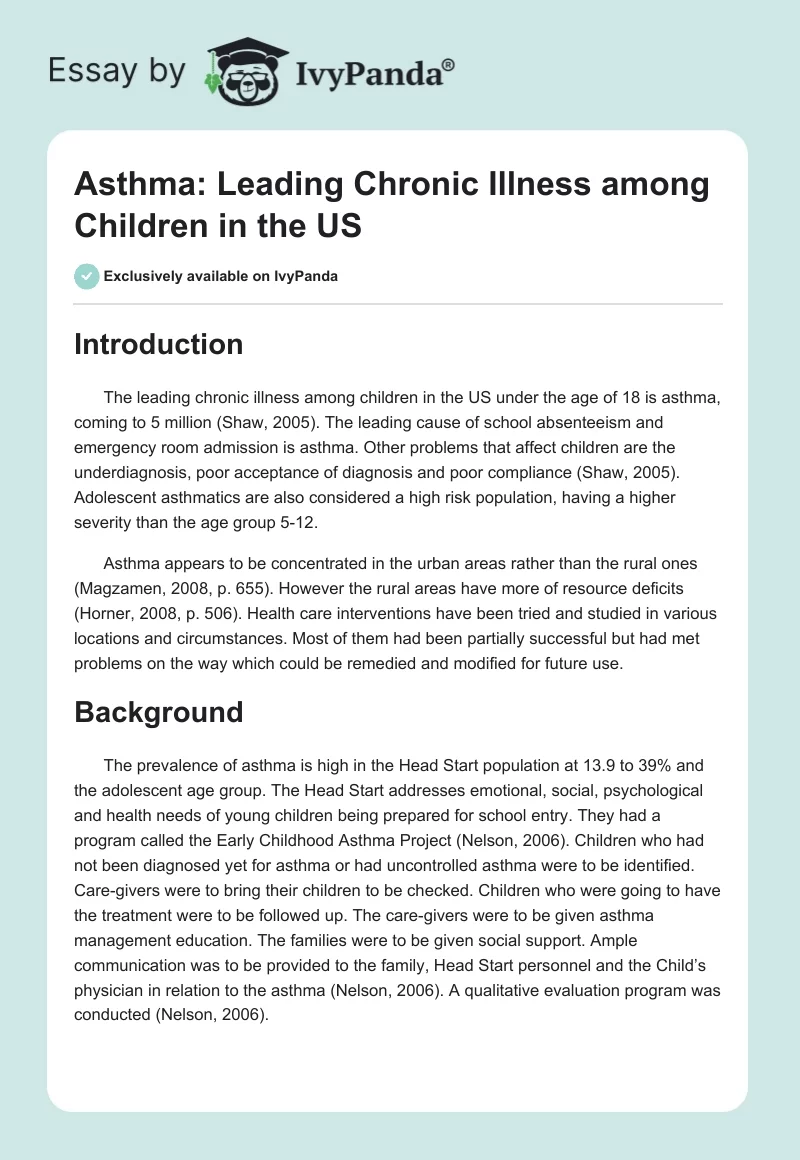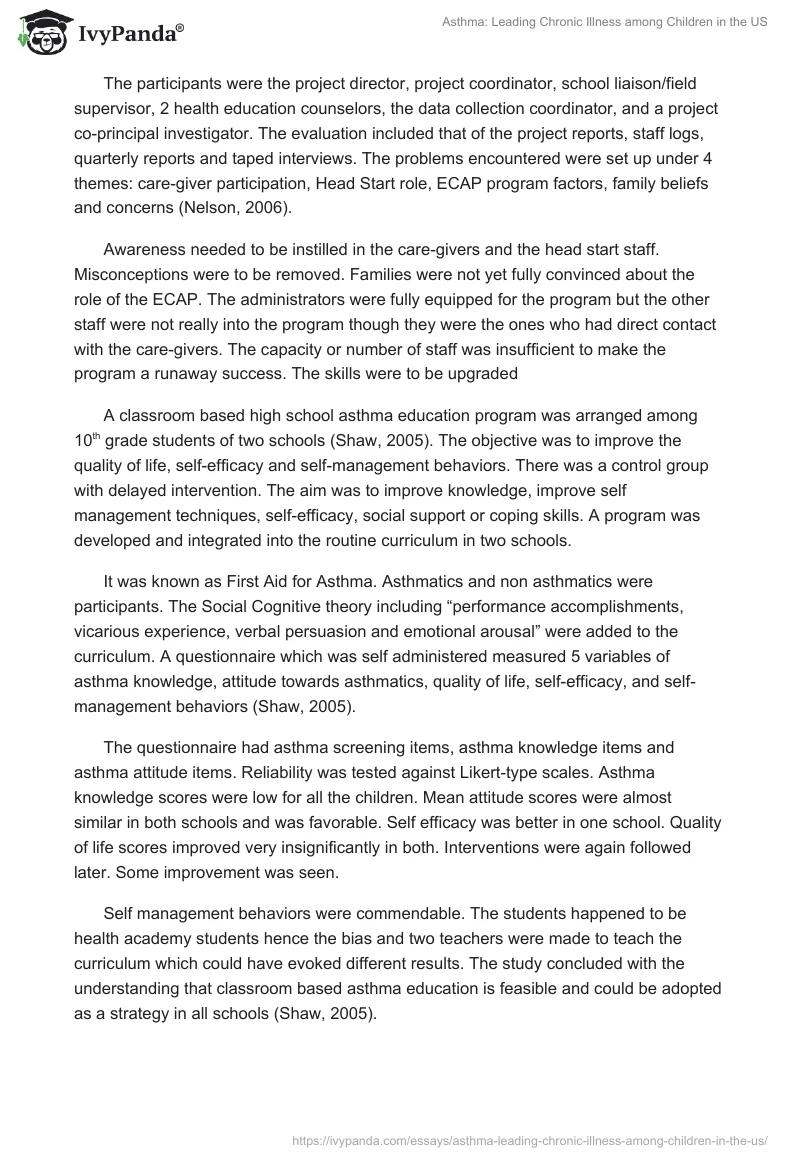Introduction
The leading chronic illness among children in the US under the age of 18 is asthma, coming to 5 million (Shaw, 2005). The leading cause of school absenteeism and emergency room admission is asthma. Other problems that affect children are the underdiagnosis, poor acceptance of diagnosis and poor compliance (Shaw, 2005). Adolescent asthmatics are also considered a high risk population, having a higher severity than the age group 5-12.
Asthma appears to be concentrated in the urban areas rather than the rural ones (Magzamen, 2008, p. 655). However the rural areas have more of resource deficits (Horner, 2008, p. 506). Health care interventions have been tried and studied in various locations and circumstances. Most of them had been partially successful but had met problems on the way which could be remedied and modified for future use.
Background
The prevalence of asthma is high in the Head Start population at 13.9 to 39% and the adolescent age group. The Head Start addresses emotional, social, psychological and health needs of young children being prepared for school entry. They had a program called the Early Childhood Asthma Project (Nelson, 2006). Children who had not been diagnosed yet for asthma or had uncontrolled asthma were to be identified. Care-givers were to bring their children to be checked. Children who were going to have the treatment were to be followed up. The care-givers were to be given asthma management education. The families were to be given social support. Ample communication was to be provided to the family, Head Start personnel and the Child’s physician in relation to the asthma (Nelson, 2006). A qualitative evaluation program was conducted (Nelson, 2006).
The participants were the project director, project coordinator, school liaison/field supervisor, 2 health education counselors, the data collection coordinator, and a project co-principal investigator. The evaluation included that of the project reports, staff logs, quarterly reports and taped interviews. The problems encountered were set up under 4 themes: care-giver participation, Head Start role, ECAP program factors, family beliefs and concerns (Nelson, 2006).
Awareness needed to be instilled in the care-givers and the head start staff. Misconceptions were to be removed. Families were not yet fully convinced about the role of the ECAP. The administrators were fully equipped for the program but the other staff were not really into the program though they were the ones who had direct contact with the care-givers. The capacity or number of staff was insufficient to make the program a runaway success. The skills were to be upgraded
A classroom based high school asthma education program was arranged among 10th grade students of two schools (Shaw, 2005). The objective was to improve the quality of life, self-efficacy and self-management behaviors. There was a control group with delayed intervention. The aim was to improve knowledge, improve self management techniques, self-efficacy, social support or coping skills. A program was developed and integrated into the routine curriculum in two schools.
It was known as First Aid for Asthma. Asthmatics and non asthmatics were participants. The Social Cognitive theory including “performance accomplishments, vicarious experience, verbal persuasion and emotional arousal” were added to the curriculum. A questionnaire which was self administered measured 5 variables of asthma knowledge, attitude towards asthmatics, quality of life, self-efficacy, and self-management behaviors (Shaw, 2005).
The questionnaire had asthma screening items, asthma knowledge items and asthma attitude items. Reliability was tested against Likert-type scales. Asthma knowledge scores were low for all the children. Mean attitude scores were almost similar in both schools and was favorable. Self efficacy was better in one school. Quality of life scores improved very insignificantly in both. Interventions were again followed later. Some improvement was seen.
Self management behaviors were commendable. The students happened to be health academy students hence the bias and two teachers were made to teach the curriculum which could have evoked different results. The study concluded with the understanding that classroom based asthma education is feasible and could be adopted as a strategy in all schools (Shaw, 2005).
A study was conducted to evaluate the Kickin’ asthma designed by health educators and local students which taught asthma physiology and self management techniques to middle and high school students at Oakland (Magzamen, 2008, p. 655). A nurse delivered the curriculum in four 50-minute sessions with 10-15 students in each series. A baseline and 3 month follow-up survey were done. A great reduction was seen in the asthma symptoms and emergency (Magzamen, 2008, p.664).
Unplanned health care utilization was less. School absences and activity limitations were also less. Asthma management behaviors improved and prevention was better by using medication. Getting students to register in the Kickin Asthma program and making them remain was a problem. The viability of the program would depend on whether schools want this program. However the program showed a marked improvement for symptoms, utilization of health care and reduction in asthma morbidity (Magzamen, 2008, p. 661).
Correct medicine usage and positive asthma behaviors were noted. The limitations in the days of activity and sleep disruption were less. Absenteeism showed marked reduction. The students who sought emergency care or hospitalization for asthma were diminished in number. Physician visits were less. Day time symptoms were declining and night-time symptoms were better. Asthma device use was better. The asthma symptoms were especially less after the intervention (Magzamen, 2008, p. 661).
A study which assessed the asthma education in rural schools was done. This was delivered by lay health educators (Horner, 2008, p. 78). Elementary school students were divided into two groups randomly. One group was given the asthma education and the other general health promotion education. Asthma knowledge, asthma self management, self efficacy for managing symptoms, metered dose inhaler technique and group interaction effects were measured and analyzed (Horner, 2008, p. 78). It was found that trained lay health educators were as efficient as any other person to deliver the classes. Training rural schoolchildren was possible under the circumstances to improve the knowledge and skills in self management of asthma.
Asthma education programs
These programs benefited families who attended the specialty care clinics and were admitted in hospital (Horner, 2008, p. 507). They improved the adult and children’s asthma. The success in improving outcomes was questionable. The health care based systems had limitations. Investigators developed various programs which could be instituted in public schools and community settings. Improvements were seen by these programs.
The asthma knowledge of parents and children and their perceptions improved. Combining school based programs with due referral to the asthma specialist had greater effects in health and outcomes. Most programs had been conducted in urban areas which showed a concentration of asthmatic children (Magzamen, 2008, p. 78). Only a handful of studies have been done in rural areas (Horner, 2008, p. 507). Nurse-delivered school based programs with a home visit to the family of an asthmatic child helped improve matters greatly where evaluation after one year showed improvement in self management and knowledge. Asthma self management education for parents and children in the rural area in a workshop format found improvements after one year too.
Educators and care-givers.
The educators vary from project counselors, nurses, schoolteachers and lay educators.
The education is well imparted whoever takes on the roles of delivering the class.
Those who get the training want to be able to be better equipped to handle the class delivery and face the questions directed at them (Nelson, 2006). Many care-givers are unwilling to participate for various reasons
Conclusion
Asthma is the leading chronic illness of schoolchildren, mostly of the adolescent age group, causing plenty of absenteeism, morbidity and poor quality of life. Asthma happens to be found mostly in congested urban areas (Magzamen, 2008, p.655). Programs are available in schools and the community for reducing the morbidity of asthma, improving the knowledge of the illness, improving self management techniques and thereby bettering the quality of life. The major drawback in most of the programs is that there is no uniformity of purpose, method of delivery and evaluation techniques. The Kickin asthma intervention indicated a good post intervention evaluation. However the program still had drawbacks in that the expected outcomes were much less. Selection of the educators does not seem problematic as most studies have fairly good results. These results could improve by correcting the drawbacks seen and improving the interventions to be used.
Hypothesis proposed
Educational Interventions improve the quality of life in the asthmatic adolescent urban school children.
Educational interventions do not improve the quality of life in the asthmatic urban school children
References
Horner, S.D. (2008). “Improvement of rural children’s asthma self management by lay health educators”. The Journal of School Health, Vol., Vol. 78, Issue 9, Pgs 506-513., ProQuest Educational Journals, American School Health Association.
Magzamen, S. et al. (2008). “Kickin Asthma: School based asthma education in an urban community”. Journal of School Health, Vol. 78, Issue 12, Pgs. 655-665. ProQuest Education Journals, American School Health Association.
Nelson, B.W. (2006). “Working With a Head Start Population With Asthma: Lessons Learned”. The Journal of School Health, Vol. 76, Issue 6. P. 273-275. ProQuest Education Journals, Kent.
Shaw, S.F. et al. (2005). “Effects of a Classroom-based Asthma Education Curriculum on Asthma Knowledge, Attitudes, Self-efficacy, Quality of Life, and Self-management Behaviors among Adolescents”. American Journal of Health Education, Vol. 36, Issue 3. Pgs 140-146, ProQuest Educational Journals, Reston.


